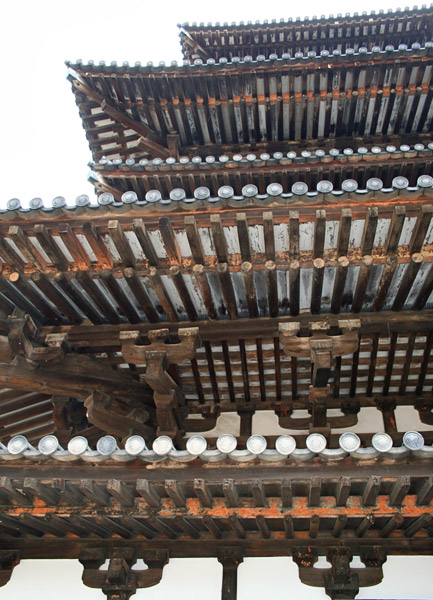|
||
 |
||

Yakushiji
Toutou 薬師寺東塔 (Nara)
(C)2001 Japanese Architecture and Art Net Users System. No reproduction or republication without written permission.
掲載のテキスト・写真・イラストなど、全てのコンテンツの無断複製・転載を禁じます。
|
||||||
| nokitenjou 軒天井 | ||||||
| KEY WORD : architecture / general terms | ||||||
| Also kotenjou 小天井. A long narrow ceiling installed under an extended eave. This type of ceiling is constructed when three-stepped bracket complexes *mitesaki tokyou 三手先斗きょう, are used to support the extended eave. It is built between the long continuous tie beam *tooshihijiki 通し肘木, running through the bearing blocks of the bracket complex directly above the pillars and the long tie beam connecting the second stepped bracket complex *futatesakigumi 二手先組. Usually non-supportive diagonal struts with an outward curve *shirin 支輪, close the gap between the second-stepped bracket complex and the eave purlin *dashigeta 出桁. If no such struts are used, the undereave ceiling is constructed out to the eave purlin. Example: Koufukuji Toukondou 興福寺東金堂 (1415) and Yakushiji Toutou 薬師寺東塔 (710) in Nara. | ||||||

Yakushiji
Toutou 薬師寺東塔 (Nara)
|
||||||
| REFERENCES: | ||||||
| EXTERNAL LINKS: | ||||||
| NOTES: | ||||||
(C)2001 Japanese Architecture and Art Net Users System. No reproduction or republication without written permission. 掲載のテキスト・写真・イラストなど、全てのコンテンツの無断複製・転載を禁じます。 |
||||||